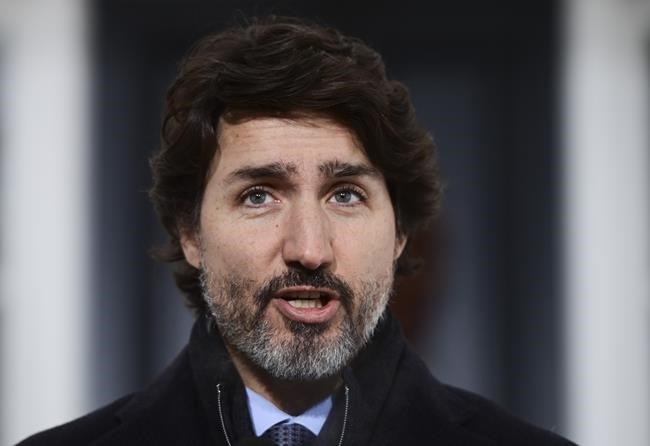OTTAWA — Signs pointed Tuesday to the COVID-19 pandemic taking a dark turn in Canada, as the prime minister voiced his own frustration with holiday travel and the slow pace of vaccine rollout.
In London, Ont., the morgue was at capacity, a field hospital was opened in Burlington, Ont., Quebec officials were mulling a near-total lockdown and New Brunswick decided to tighten up as well as cases continued to rise at an accelerated pace.
Canada's chief public health officer Dr. Theresa Tam noted it took five months for Canada to hit 500,000 cases. But now, it is taking just two weeks for 100,000 new cases to emerge.
"This ever-more-rapid accumulation of cases will continue until we can make significant progress in interrupting spread, which is why we must all continue our efforts," she said at a briefing in Ottawa.
While officials said upwards of a million doses of COVID-19 vaccines will arrive by month's end, the pace at which they're being administered is only just starting to accelerate.
As vaccines arrive, they are transferred to the provinces, which have control over administering the shots to individual recipients, and how fast that is happening varies wildly across the country.
An effort at Britain's University of Oxford to track global COVID-19 vaccination efforts suggests overall, Canada is in eighth place when it comes to the rate of vaccinations, but that pace is well behind the U.K and the United States.
What the federal government could do to speed things up will be on the agenda at a meeting between Prime Minister Justin Trudeau and his provincial and territorial counterparts Thursday.
"I think all Canadians, including me, are frustrated to see vaccines in freezers and not in people's arms," Trudeau said.
Maj.-Gen. Dany Fortin, who is overseeing vaccine distribution, said efforts continue to reinforce the infrastructure required to store and transport vaccines, as well as expand distribution networks.
"I want to reaffirm to all Canadians that while quantities seem limited, we are scaling up," he said.
"This is a deliberate operation."
Nunavut's chief public health officer said the first doses there are to be given Wednesday to residents at Iqaluit's elders home, following the arrival of the Moderna vaccine in the territory last week.
Of the two vaccines currently approved for use in Canada, Moderna's is less demanding of being stored at ultralow temperatures, making it easier to transport to remote locations.
The first shipment of Moderna vaccines arrived in Manitoba Tuesday, and will be used to address priority First Nations populations; First Nations represent 30 per cent of the new cases in the province, according to data released Tuesday.
Nova Scotia also rolled out its vaccination plan Tuesday, saying it intends to make the vaccine available to 75 per cent of the eligible population by the end of September, and focus on high-priority populations over the next four months.
In Ontario, provincial authorities promised all long-term-care residents, workers and essential caregivers in COVID-19 hot spots will be vaccinated by Jan. 21 and vaccinations in Ontario's Indigenous communities will begin later this week.
So far, the province has received 95,000 doses of the Pfizer-BioNtech vaccine and 53,000 doses of the Moderna vaccine.
About 50,000 long-term care home residents have received the Pfizer-BioNTech vaccine, while nearly 3,000 doses of the Moderna vaccine have also been administered.
"We're ramping up," Ontario Premier Doug Ford said. "I just look forward to getting more vaccines, that's what we need."
In Quebec a total of 32,763 vaccines have been administered so far.
A rising daily case count — more than 2,500 new diagnoses a day for the last several days — has officials mulling a nearly complete shutdown of the province, including schools, and imposing a curfew, some reports said.
While Canadians await the sharp sting of the needle, many are also feeling the sharp sting of watching friends and neighbours return from holiday vacations abroad and potentially accessing federal paid sick leave to cover off their two-week quarantine requirement.
Trudeau stressed Tuesday the federal sick-leave benefit, worth up to $1,000, was introduced so Canadians wouldn't feel pressure to go to work with COVID-19 symptoms, not as a safety net to help people who head out on vacation.
"We didn't imagine when we passed it unanimously in the House with the support of all parties, that people would use it to pay for their quarantines after having gone south for a two-week vacation," he said.
"So that is something we are going to fix right now."
He also expressed disappointment in federal and provincial politicians who travelled abroad, despite months of recommendations against non-essential travel.
"As leaders we've been encouraging and exhorting Canadians to continue to do the right thing," he said.
"So it is unfortunate to see a number of politicians not take their own advice."
How the federal government could crack down further on discretionary travel is unclear.
A two-week ban on flights into Canada from the U.K. due to a more transmissible variant of the novel coronavirus circulating there expires Jan. 6, and Trudeau did not directly answer a question about whether it will be extended.
Intergovernmental Affairs Minister Dominic LeBlanc said the federal government will look at just about any measure to discourage people from travelling internationally.
But he says Canada doesn't want to join the short list of countries that require government approval for travel, with measures such as exit visas.
This report by The Canadian Press was first published Jan. 5, 2021.
Stephanie Levitz, The Canadian Press




